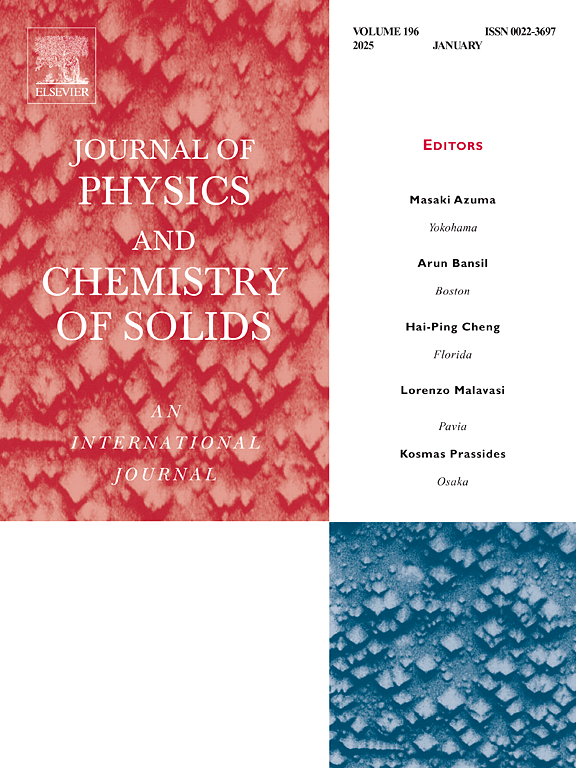Ab-initio investigation of carbon-doped χ3 borophene for Na and K storage as post lithium-ion batteries
IF 4.3
3区 材料科学
Q2 CHEMISTRY, MULTIDISCIPLINARY
引用次数: 0
Abstract
Reducing pollution problems caused by fossil fuels requires providing advanced solutions for storing clean energy. Today, rechargeable lithium-ion batteries (LIBS) are an integral part of energy storage technologies. But, due to the problems caused by lithium sources, the need to replace them is felt more than ever. Among emerging alternatives to LIBs, sodium and potassium ion batteries (SIBS and PIBS) stand out due to their natural abundance and economic efficiency. This study explores χ3 borophene as a high-performance anode material for SIBs and PIBs through density functional theory (DFT) and ab initio molecular dynamics (AIMD) simulations. The results reveal that carbon-doped χ3 borophene demonstrates a metallic characteristic, ensuring high electrical conductivity. AIMD calculations indicate that the material has structural stability at 300 K. With ultralow diffusion energy barriers of 0.22 eV and 0.14 eV for Na, and 0.11 eV and 0.09 eV for K, enabling efficient ion mobility that is vital in fast charging technology. Notably, it delivers a high theoretical storage capacity of 822 mAhg−1 for both Na and K, coupled with competitive open-circuit voltages of 0.72 V (Na) and 1.36 V (K). AIMD simulations further validate its thermal stability under full Na and K adsorption at 300 K. These outstanding properties establish carbon-doped borophene as a robust and high-performance anode candidate for future alkali metal-ion battery technologies.
掺杂碳的硼罗芬作为后锂离子电池存储Na和K的Ab-initio研究
减少化石燃料造成的污染问题需要提供储存清洁能源的先进解决方案。如今,可充电锂离子电池(LIBS)已成为储能技术的重要组成部分。但是,由于锂源引起的问题,人们比以往任何时候都更需要替换它们。在锂离子电池的新兴替代品中,钠和钾离子电池(SIBS和PIBS)因其天然丰度和经济效率而脱颖而出。本研究通过密度泛函理论(DFT)和从头算分子动力学(AIMD)模拟,探讨硼罗芬作为sib和pib的高性能阳极材料。结果表明,碳掺杂的硼罗芬具有金属特性,保证了高导电性。AIMD计算表明,该材料在300k时具有结构稳定性。Na的扩散能垒为0.22 eV和0.14 eV, K的扩散能垒为0.11 eV和0.09 eV,实现了快速充电技术中至关重要的高效离子迁移。值得注意的是,它为Na和K提供了822 mAhg−1的高理论存储容量,加上0.72 V (Na)和1.36 V (K)的竞争开路电压。AIMD模拟进一步验证了其在300 K下完全吸附Na和K的热稳定性。这些优异的性能使碳掺杂硼罗芬成为未来碱金属离子电池技术中坚固、高性能的阳极候选材料。
本文章由计算机程序翻译,如有差异,请以英文原文为准。
求助全文
约1分钟内获得全文
求助全文
来源期刊
CiteScore
7.80
自引率
2.50%
发文量
605
审稿时长
40 days
期刊介绍:
The Journal of Physics and Chemistry of Solids is a well-established international medium for publication of archival research in condensed matter and materials sciences. Areas of interest broadly include experimental and theoretical research on electronic, magnetic, spectroscopic and structural properties as well as the statistical mechanics and thermodynamics of materials. The focus is on gaining physical and chemical insight into the properties and potential applications of condensed matter systems.
Within the broad scope of the journal, beyond regular contributions, the editors have identified submissions in the following areas of physics and chemistry of solids to be of special current interest to the journal:
Low-dimensional systems
Exotic states of quantum electron matter including topological phases
Energy conversion and storage
Interfaces, nanoparticles and catalysts.

 求助内容:
求助内容: 应助结果提醒方式:
应助结果提醒方式:


